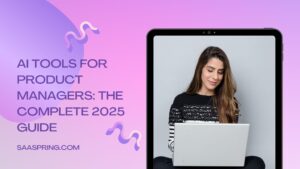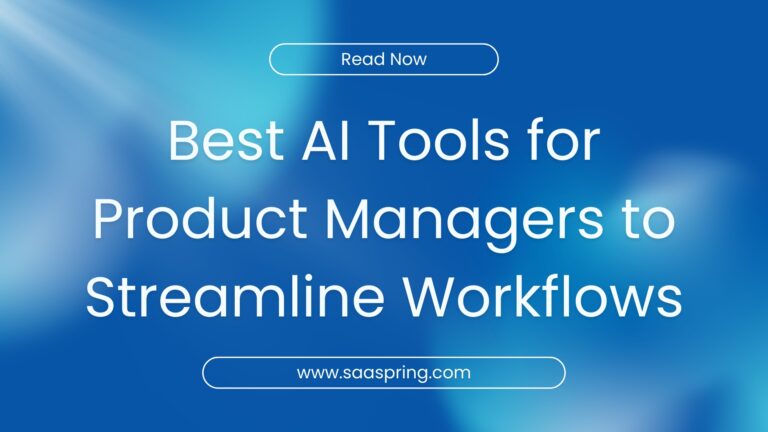The New Era of AI tools for Product Managers is here. The Product Manager role is more complex than ever before. You handle data, research, and communication. Furthermore, this can feel incredibly overwhelming.

However, a powerful solution is emerging. AI tools for Product Managers are changing the game. These tools automate many repetitive tasks. They also provide much deeper insights.
This post will explore this shift. We will show how AI is now a modern necessity. Thus, it is more than just a passing trend. We will cover specific AI tools. We will also discuss their applications across the product lifecycle.
II. The Impact of AI on the Product Lifecycle: Practical AI Tools for Product Managers
AI assists at every stage of the product lifecycle. It streamlines your workflow. Consequently, it frees you to focus on strategy. This partnership is the future of product management.
A. AI in Discovery & Research: Essential AI Tools for Product Managers
AI can synthesize huge amounts of data. It analyzes user feedback and market trends. Furthermore, it studies competitor analysis. This helps you identify new opportunities. Therefore, your product ideas are much stronger.
B. AI in Strategy & Planning: How AI Tools for Product Managers Shape Your Roadmap
AI assists with forecasting. It also helps with prioritization. In addition, it helps with roadmapping. It provides data-driven recommendations. This makes your strategy more robust. Therefore, your plans are more likely to succeed.
C. AI in Execution & Development: The Role of AI Tools for Product Managers
AI can improve team communication. It analyzes feature usage data. This data helps with A/B testing. It also guides optimization. Consequently, your development process becomes more efficient.
D. AI in Launch & Post-Launch: Using AI Tools for Product Managers Effectively
AI plays a key role after launch. It analyzes your launch performance. It identifies user sentiment. Furthermore, it automates report generation. This gives you a clear picture of success.
III. Key AI Tools for Product Managers: A Curated List of AI Tools for Product Managers
Many AI tools are available today. These are some of the most impactful ones. Each tool helps with a specific PM task.
A. Generative AI for Content & Communication: Versatile AI Tools for Product Managers
These tools are powerful writing assistants. Examples include ChatGPT, Gemini, and Jasper. They automate many content tasks.
You can create user stories and PRDs. You can also write marketing copy. In addition, they help with release notes. This saves you valuable time.
B. Data & Analytics Platforms: Insightful AI Tools for Product Managers
Many platforms are now AI-enhanced. Mixpanel and Amplitude are great examples. They identify user behavior patterns. They also predict user churn.
Consequently, they provide actionable insights. All this happens without manual data crunching. They simplify complex data.
C. User Feedback & Sentiment Analysis: Smart AI Tools for Product Managers
These tools manage user feedback. Examples are UserTesting and Sprig. They automatically tag and categorize feedback. They also summarize sentiment from support tickets.
Therefore, they highlight key pain points. This makes it easier to listen to your users. You can act on their feedback faster.
D. Prioritization & Roadmapping Tools: Strategic AI Tools for Product Managers
AI-driven frameworks are transforming prioritization. Consider tools like Productboard and Aha! They use data to score feature requests.
They suggest a balanced roadmap. This roadmap aligns with business goals. It also considers user impact. Thus, your roadmap is smarter.
E. Automated Project Management: Efficient AI Tools for Product Managers
Project management software now has AI features. For instance, Jira and Asana. They automate task creation. Also estimate project timelines. They can identify potential bottlenecks. This makes your sprints more efficient.
IV. Best Practices for Integrating AI Tools: How to Use AI Tools for Product Managers Effectively
Integrating AI requires a smart approach. Do not just adopt tools blindly. Follow these best practices.
A. Start with a Specific Problem: A Foundational Best Practice for AI Tools for Product Managers
Identify a clear pain point first. Maybe you need to summarize feedback. Perhaps you need to automate a report.
Do not adopt AI just because it is new. A tool should solve a real problem. This ensures a good return on your investment.
B. Focus on Augmentation, Not Replacement: The Human-AI Partnership for Product Managers
AI is meant to assist you. It should not replace your intelligence. Your strategic role remains central.
AI handles repetitive tasks. You focus on high-level strategy. This is a powerful partnership.
C. The Importance of Data: Fueling AI Tools for Product Managers
AI tools need good data. They require clean, well-structured information. This ensures accurate and meaningful results.
Bad data will lead to bad insights. So, prioritize data quality. It is the fuel for your AI tools.
D. Pilot and Iterate: Testing Your New AI Tools for Product Managers
Test new tools carefully. Start with a small team or project. Measure their effectiveness first.
Gather feedback from your team. Adjust your process as needed. This helps you find the right fit.
V. Conclusion: The Future is AI-Powered Product Management and its Tools
You have explored many AI tools for Product Managers. These tools streamline workflows. They provide deeper insights. They also enable smarter decision-making.
The PM role is evolving. It is becoming a partnership with AI. This allows PMs to focus on high-impact, creative work. It empowers you to be more strategic.
Start your journey into AI-powered product management. Explore these tools. Embrace the future of your role.
Also Read: How to Use AI Writing Tools For Bloggers — A Step-by-Step Guide


